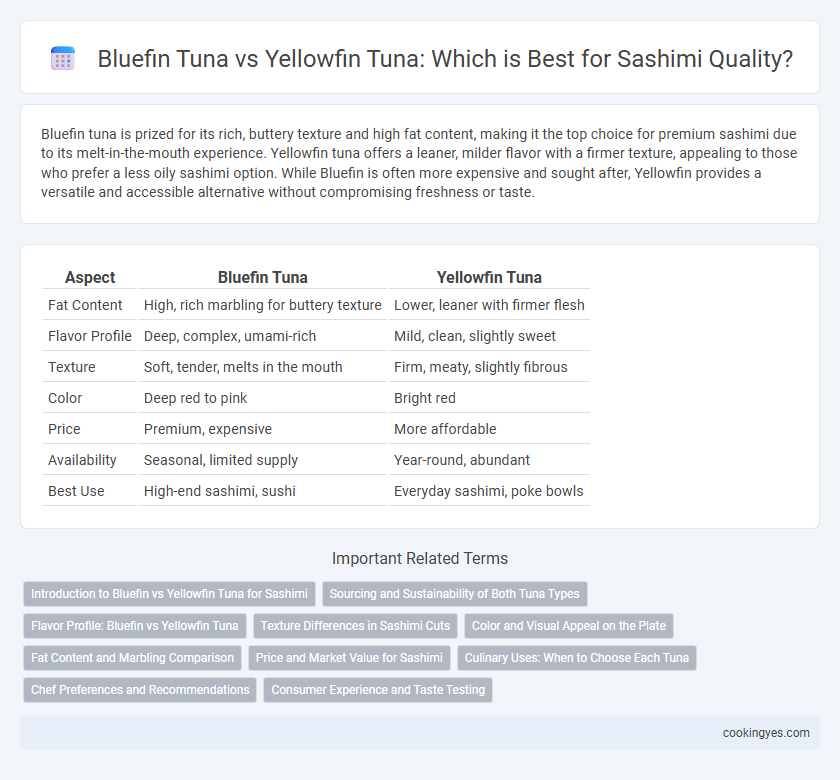Bluefin tuna is prized for its rich, buttery texture and high fat content, making it the top choice for premium sashimi due to its melt-in-the-mouth experience. Yellowfin tuna offers a leaner, milder flavor with a firmer texture, appealing to those who prefer a less oily sashimi option. While Bluefin is often more expensive and sought after, Yellowfin provides a versatile and accessible alternative without compromising freshness or taste.
Table of Comparison
| Aspect | Bluefin Tuna | Yellowfin Tuna |
|---|---|---|
| Fat Content | High, rich marbling for buttery texture | Lower, leaner with firmer flesh |
| Flavor Profile | Deep, complex, umami-rich | Mild, clean, slightly sweet |
| Texture | Soft, tender, melts in the mouth | Firm, meaty, slightly fibrous |
| Color | Deep red to pink | Bright red |
| Price | Premium, expensive | More affordable |
| Availability | Seasonal, limited supply | Year-round, abundant |
| Best Use | High-end sashimi, sushi | Everyday sashimi, poke bowls |
Introduction to Bluefin vs Yellowfin Tuna for Sashimi
Bluefin tuna is prized for sashimi due to its rich marbling and high fat content, offering a buttery texture and deep umami flavor that elevates the eating experience. Yellowfin tuna, while leaner and milder in taste, provides a firmer texture and bright red color, making it a popular, affordable choice for sashimi lovers seeking a fresh and clean flavor. The distinct fat distribution and flavor profiles between Bluefin and Yellowfin tuna directly influence sashimi quality, with Bluefin often regarded as premium and Yellowfin as a versatile alternative.
Sourcing and Sustainability of Both Tuna Types
Bluefin tuna, prized for its rich marbling and deep flavor, is often sourced from carefully managed fisheries but faces significant sustainability challenges due to overfishing and slow reproduction rates. Yellowfin tuna, while milder in taste and texture, is more abundant and commonly harvested via pole-and-line or FAD-free methods, enhancing its sustainability profile. Sustainable sourcing certifications like MSC and adherence to quotas are critical for both tuna types to support healthy populations and responsible sashimi production.
Flavor Profile: Bluefin vs Yellowfin Tuna
Bluefin tuna sashimi is prized for its rich, buttery texture and intense umami flavor, offering deep, fatty notes due to higher fat content, especially in the prized toro cuts. Yellowfin tuna sashimi presents a milder, cleaner taste with a firmer texture and less fat, appealing to those who prefer a more delicate, less oily flavor profile. The pronounced marbling of Bluefin enhances the overall sashimi experience with a melt-in-the-mouth sensation, while Yellowfin provides a fresh, slightly sweet taste suitable for lighter preparations.
Texture Differences in Sashimi Cuts
Bluefin tuna sashimi is prized for its rich, buttery texture and high-fat marbling, creating a melt-in-the-mouth experience ideal for premium cuts like Otoro. In comparison, Yellowfin tuna sashimi offers a firmer, leaner texture with a slightly more fibrous bite, appealing to those who prefer a cleaner, meatier taste. The texture difference significantly influences sashimi presentation and pairing, with Bluefin commonly used for luxurious, delicate slices and Yellowfin favored for robust, textured servings.
Color and Visual Appeal on the Plate
Bluefin tuna sashimi is prized for its deep red, almost ruby-like color that signals high fat content and rich flavor, elevating the visual appeal on the plate. Yellowfin tuna features a lighter pink hue, offering a cleaner, more vibrant appearance but with less marbling compared to Bluefin. The intense color contrast of Bluefin enhances presentation, making it a preferred choice for premium sashimi dishes.
Fat Content and Marbling Comparison
Bluefin tuna sashimi is prized for its superior fat content and intense marbling, resulting in a rich, buttery texture and deep umami flavor. Yellowfin tuna, while leaner with less intramuscular fat, offers a firmer texture and milder taste, which some prefer for a cleaner sashimi experience. The higher fat content in Bluefin particularly enhances the melt-in-the-mouth sensation, making it the premium choice for sashimi connoisseurs seeking luxurious mouthfeel and flavor complexity.
Price and Market Value for Sashimi
Bluefin tuna commands a significantly higher price and market value in the sashimi industry due to its rich marbling, superior fat content, and prized flavor profile. Yellowfin tuna is more affordable and widely available, making it a popular choice for sashimi but lacking the premium quality and luxury status attributed to Bluefin. The scarcity and high demand for Bluefin tuna consistently drive its market value above Yellowfin, especially in upscale sushi and sashimi establishments.
Culinary Uses: When to Choose Each Tuna
Bluefin tuna is prized for sashimi due to its rich, fatty texture and deep flavor, making it ideal for premium, melt-in-the-mouth dishes. Yellowfin tuna offers a leaner, milder taste with a firmer texture, perfect for lighter sashimi preparations and those seeking a less intense flavor. Choosing Bluefin suits luxury dining experiences, while Yellowfin is preferred for everyday sashimi that balances taste and affordability.
Chef Preferences and Recommendations
Bluefin tuna is favored by sashimi chefs for its rich marbling and buttery texture, offering a higher fat content that enhances flavor and mouthfeel. Yellowfin tuna, while leaner and firmer, is often recommended for a cleaner, milder taste that appeals to those seeking a lighter sashimi experience. Expert chefs typically select Bluefin for premium dishes and Yellowfin for versatile preparations, balancing flavor intensity and texture preferences.
Consumer Experience and Taste Testing
Bluefin tuna sashimi is highly prized for its rich, buttery texture and intense umami flavor, offering a melt-in-the-mouth experience favored by connoisseurs. Yellowfin tuna provides a milder taste with a slightly firmer texture, appealing to consumers who prefer a cleaner, more subtle seafood flavor. Taste tests reveal Bluefin's higher fat content enhances flavor complexity, while Yellowfin is often chosen for freshness and affordability in sashimi dishes.
Bluefin tuna vs Yellowfin tuna for sashimi quality Infographic

 cookingyes.com
cookingyes.com